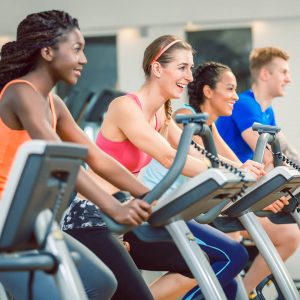How to Spin Safely and Avoid Spin Class Injuries
Spin mistakes to avoid
Spin class has been a staple at gyms for years, and with plenty of at-home spin bike options, it has become increasingly popular—and with good reason. Not only is it low-impact (which reduces stress on joints) and high-intensity (excellent for cardiovascular fitness), but it’s a whole lot of fun, and you can ride inside all year round.
Spinning, or indoor cycling, can improve your overall health, but improper technique can lead to injuries. You can reduce your risk with some simple precautions. Our specialists, how to warm up, train, fit your bike, and more—all so you can enjoy the ride, safely.
How to warm up
Before you hop on your bike, it’s important to warm up. Warming up provides your body with time to prepare for the workout ahead and reduces your risk of injury by increasing blood flow to your muscles.
Try a dynamic warm-up, where you complete movements at a slower pace and reduced intensity to prepare your muscles for the workout. Some dynamic warm-ups for spinning include:
- Brisk walks
- Light jogs
- High knees
- Walking knee-to-chest
- Straight leg kicks
- Lunge walks with a twist
- Jumping jacks
Gradually increase workload
When you first start cycling, take it slow and increase the intensity of your workout over time. While you may be excited to work hard from the get-go, you need to give your body time to adjust. Riding too aggressively without proper training can lead to injury. Instead, build your endurance and strength at a slower pace giving your body time to adapt.
How to train
When it comes to cycling and the effort exerted, there are two primary performance indicators:
- Volume: The amount of work you are completing. You can measure this with your total riding time or distance.
- Intensity: How hard you work. You can measure this with several factors, including cadence (rotations per minute), heart rate, and speed.
To safely advance your training, you should adjust these factors inversely. So, if volume increases, the intensity should decrease—and vice versa. Alternate the types of workouts you complete each day (high volume vs. high intensity) to give your body time to recover.
Bike adjustments to make
There’s a reason why your spin bike comes with adjustments—so it’s important to fit your bike to your body. Adjusting your spin bike to your height will not only prevent injury, but it will enhance your performance.
Here are some adjustments to make before riding:
Seat height
Stand next to your bike and lift one leg off the ground, so your thigh is parallel to the floor. Proper seat position should be level with your raised thigh.
Handlebar height
Position your handlebars either level with or slightly higher than the saddle—there should be a slight bend in your elbows. If handlebars are too low, it can put excessive force on your arms and wrists. Conversely, if handlebars are too high, your performance will be less efficient.
Leg position
After adjusting your seat and handlebar height, you can see if your leg position is correct. Here’s how you can check:
- When sitting on the bike, move the pedal to the lowest position on one side. On that side, your knee should be slightly bent.
- When both pedals are parallel to the ground, your front knee should line up with the middle of your opposite foot.
Proper body mechanics
Spinning for long periods with poor posture or improper form can lead to unnecessary discomfort, increased fatigue, and overuse injuries. Correct your body mechanics with these tips:
- Keep your spine straight
- Knees should be in line with hips and feet
- Keep shoulders relaxed
- Elbows should have a slight bend
- Gently grip handlebars
- Distribute weight equally from your hips to your arms
How to cool down
Just like warm-ups ease your body into a workout, cool downs ease you out of strenuous activity—gradually lowering your heart rate. Cool downs also reduce muscle soreness and tightness. You can cool down with five to 10 minutes of riding with decreased intensity.
After your cool down, you can finish your workout with static stretching, which can help overworked muscles recover faster.
Indoor cycling is a great way to improve cardiovascular health and overall strength. In addition to following these precautions, be sure to listen to your body. If you’re experiencing pain during your spin workout, it’s best to stop riding and seek treatment. Addressing an injury—and even nagging discomforts—can help you recover faster and prevent more severe injuries.
At Orlin & Cohen, our network of offices is open seven days a week. Our premier team of fellowship-trained sports medicine specialists have the expertise and experience to help you feel better and get back in the saddle, faster. Request an appointment.
Written by Ryan Power & Jordan Placella




